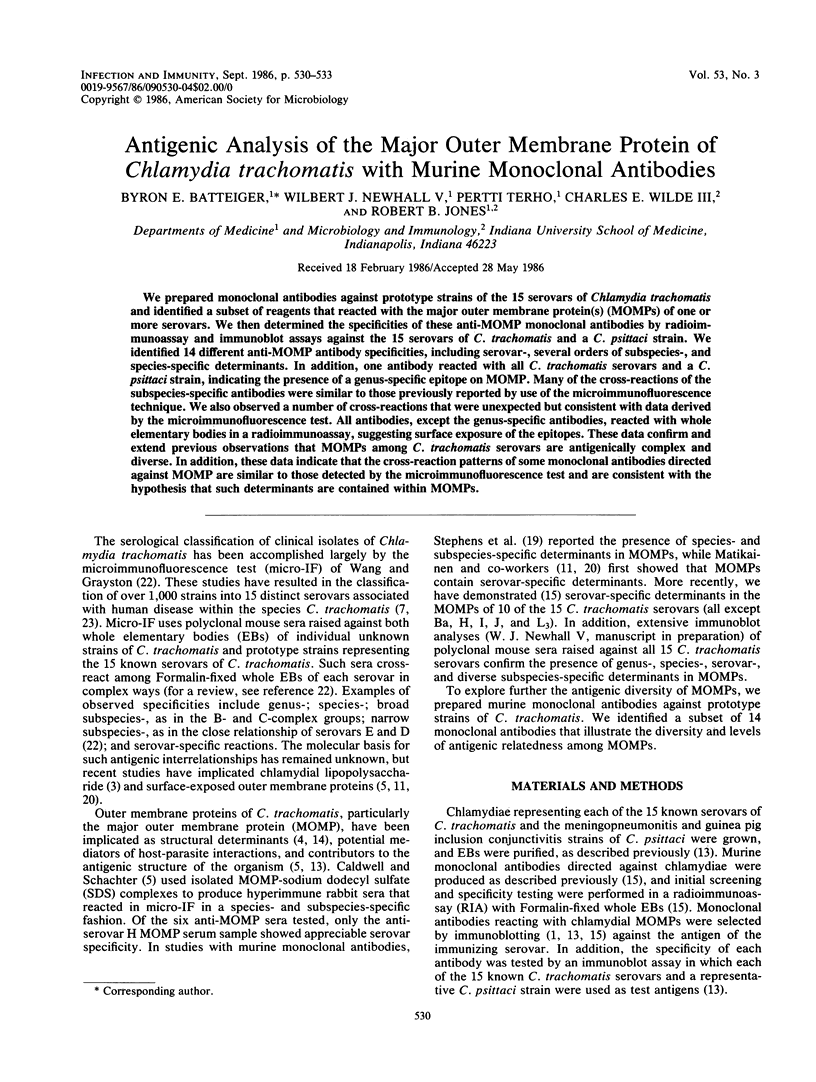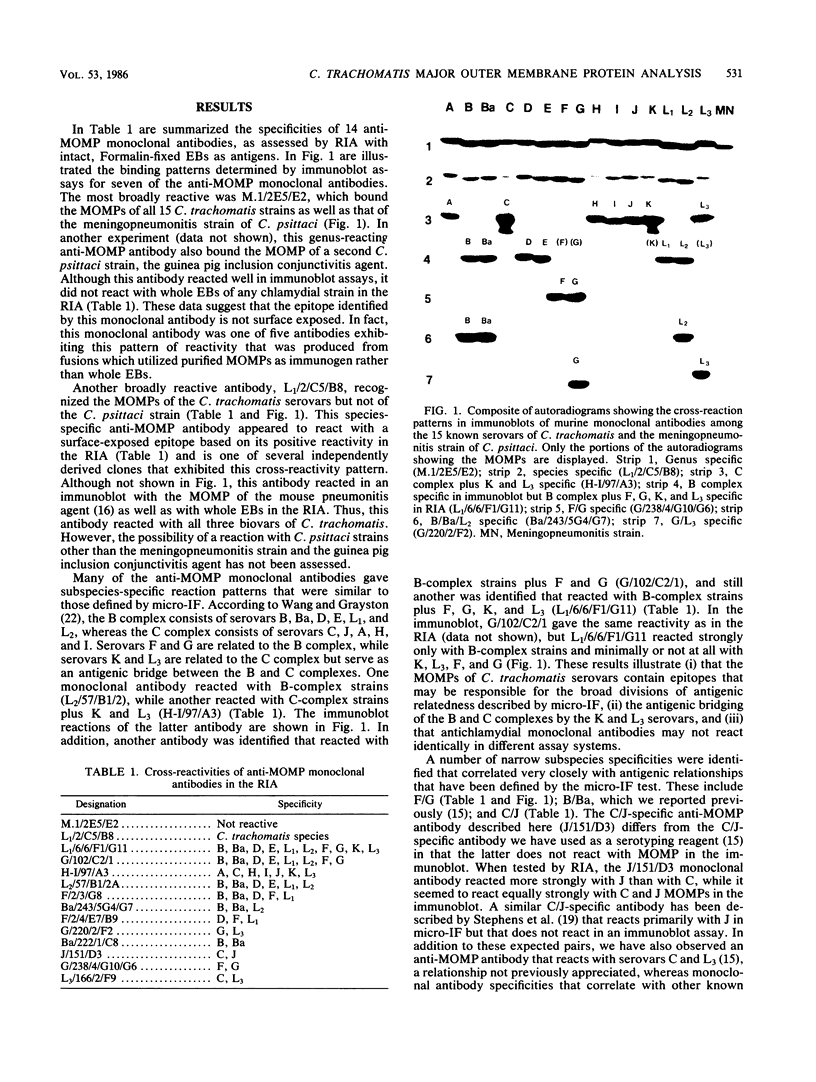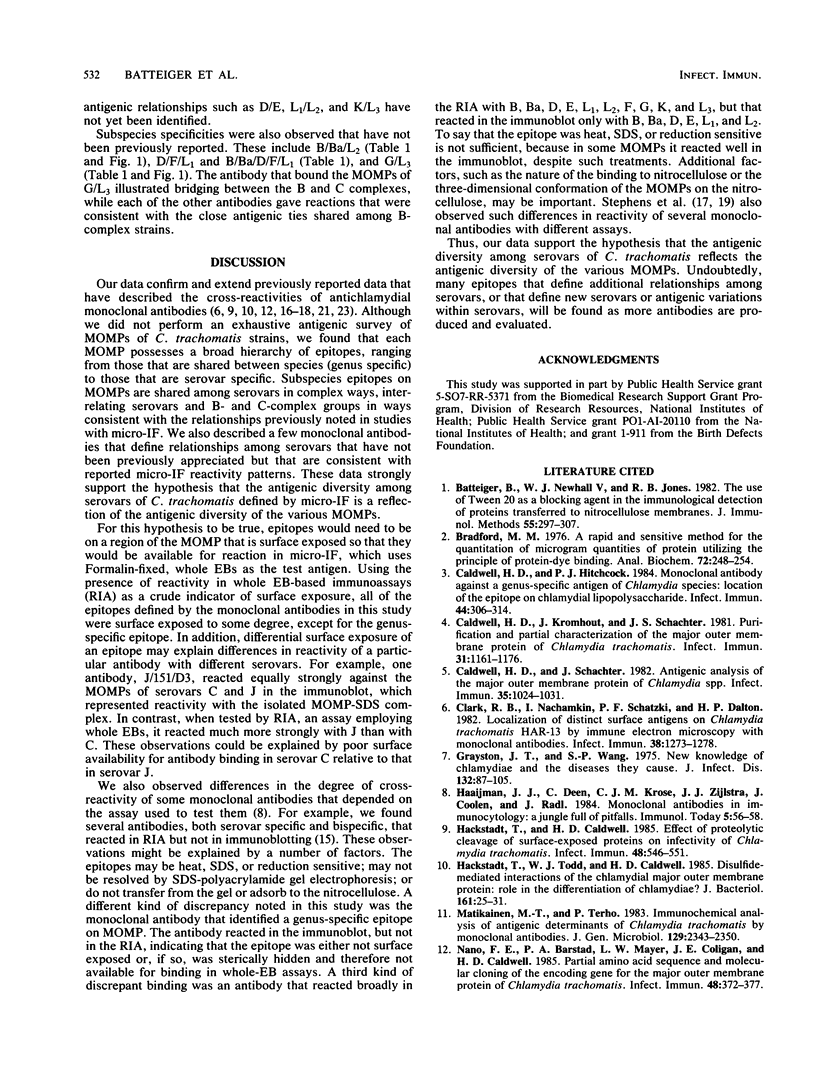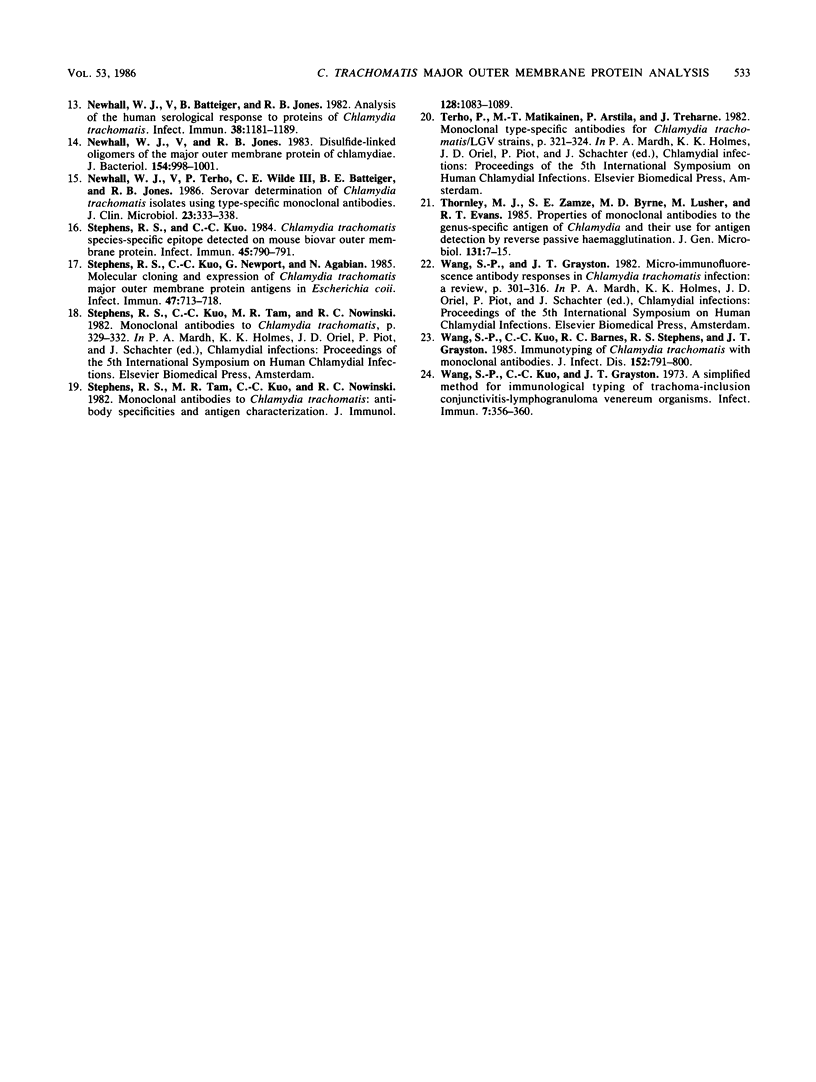Abstract
We prepared monoclonal antibodies against prototype strains of the 15 serovars of Chlamydia trachomatis and identified a subset of reagents that reacted with the major outer membrane protein(s) (MOMPs) of one or more serovars. We then determined the specificities of these anti-MOMP monoclonal antibodies by radioimmunoassay and immunoblot assays against the 15 serovars of C. trachomatis and a C. psittaci strain. We identified 14 different anti-MOMP antibody specificities, including serovar-, several orders of subspecies-, and species-specific determinants. In addition, one antibody reacted with all C. trachomatis serovars and a C. psittaci strain, indicating the presence of a genus-specific epitope on MOMP. Many of the cross-reactions of the subspecies-specific antibodies were similar to those previously reported by use of the microimmunofluorescence technique. We also observed a number of cross-reactions that were unexpected but consistent with data derived by the microimmunofluorescence test. All antibodies, except the genus-specific antibodies, reacted with whole elementary bodies in a radioimmunoassay, suggesting surface exposure of the epitopes. These data confirm and extend previous observations that MOMPs among C. trachomatis serovars are antigenically complex and diverse. In addition, these data indicate that the cross-reaction patterns of some monoclonal antibodies directed against MOMP are similar to those detected by the microimmunofluorescence test and are consistent with the hypothesis that such determinants are contained within MOMPs.
Full text
PDF



Images in this article
Selected References
These references are in PubMed. This may not be the complete list of references from this article.
- Batteiger B., Newhall W. J., 5th, Jones R. B. The use of Tween 20 as a blocking agent in the immunological detection of proteins transferred to nitrocellulose membranes. J Immunol Methods. 1982 Dec 30;55(3):297–307. doi: 10.1016/0022-1759(82)90089-8. [DOI] [PubMed] [Google Scholar]
- Bradford M. M. A rapid and sensitive method for the quantitation of microgram quantities of protein utilizing the principle of protein-dye binding. Anal Biochem. 1976 May 7;72:248–254. doi: 10.1016/0003-2697(76)90527-3. [DOI] [PubMed] [Google Scholar]
- Caldwell H. D., Hitchcock P. J. Monoclonal antibody against a genus-specific antigen of Chlamydia species: location of the epitope on chlamydial lipopolysaccharide. Infect Immun. 1984 May;44(2):306–314. doi: 10.1128/iai.44.2.306-314.1984. [DOI] [PMC free article] [PubMed] [Google Scholar]
- Caldwell H. D., Kromhout J., Schachter J. Purification and partial characterization of the major outer membrane protein of Chlamydia trachomatis. Infect Immun. 1981 Mar;31(3):1161–1176. doi: 10.1128/iai.31.3.1161-1176.1981. [DOI] [PMC free article] [PubMed] [Google Scholar]
- Caldwell H. D., Schachter J. Antigenic analysis of the major outer membrane protein of Chlamydia spp. Infect Immun. 1982 Mar;35(3):1024–1031. doi: 10.1128/iai.35.3.1024-1031.1982. [DOI] [PMC free article] [PubMed] [Google Scholar]
- Clark R. B., Nachamkin I., Schatzki P. F., Dalton H. P. Localization of distinct surface antigens on Chlamydia trachomatis HAR-13 by immune electron microscopy with monoclonal antibodies. Infect Immun. 1982 Dec;38(3):1273–1278. doi: 10.1128/iai.38.3.1273-1278.1982. [DOI] [PMC free article] [PubMed] [Google Scholar]
- Grayston J. T., Wang S. New knowledge of chlamydiae and the diseases they cause. J Infect Dis. 1975 Jul;132(1):87–105. doi: 10.1093/infdis/132.1.87. [DOI] [PubMed] [Google Scholar]
- Hackstadt T., Caldwell H. D. Effect of proteolytic cleavage of surface-exposed proteins on infectivity of Chlamydia trachomatis. Infect Immun. 1985 May;48(2):546–551. doi: 10.1128/iai.48.2.546-551.1985. [DOI] [PMC free article] [PubMed] [Google Scholar]
- Hackstadt T., Todd W. J., Caldwell H. D. Disulfide-mediated interactions of the chlamydial major outer membrane protein: role in the differentiation of chlamydiae? J Bacteriol. 1985 Jan;161(1):25–31. doi: 10.1128/jb.161.1.25-31.1985. [DOI] [PMC free article] [PubMed] [Google Scholar]
- Matikainen M. T., Terho P. Immunochemical analysis of antigenic determinants of Chlamydia trachomatis by monoclonal antibodies. J Gen Microbiol. 1983 Aug;129(8):2343–2350. doi: 10.1099/00221287-129-8-2343. [DOI] [PubMed] [Google Scholar]
- Nano F. E., Barstad P. A., Mayer L. W., Coligan J. E., Caldwell H. D. Partial amino acid sequence and molecular cloning of the encoding gene for the major outer membrane protein of Chlamydia trachomatis. Infect Immun. 1985 May;48(2):372–377. doi: 10.1128/iai.48.2.372-377.1985. [DOI] [PMC free article] [PubMed] [Google Scholar]
- Newhall W. J., 5th, Terho P., Wilde C. E., 3rd, Batteiger B. E., Jones R. B. Serovar determination of Chlamydia trachomatis isolates by using type-specific monoclonal antibodies. J Clin Microbiol. 1986 Feb;23(2):333–338. doi: 10.1128/jcm.23.2.333-338.1986. [DOI] [PMC free article] [PubMed] [Google Scholar]
- Newhall W. J., Batteiger B., Jones R. B. Analysis of the human serological response to proteins of Chlamydia trachomatis. Infect Immun. 1982 Dec;38(3):1181–1189. doi: 10.1128/iai.38.3.1181-1189.1982. [DOI] [PMC free article] [PubMed] [Google Scholar]
- Newhall W. J., Jones R. B. Disulfide-linked oligomers of the major outer membrane protein of chlamydiae. J Bacteriol. 1983 May;154(2):998–1001. doi: 10.1128/jb.154.2.998-1001.1983. [DOI] [PMC free article] [PubMed] [Google Scholar]
- Stephens R. S., Kuo C. C. Chlamydia trachomatis species-specific epitope detected on mouse biovar outer membrane protein. Infect Immun. 1984 Sep;45(3):790–791. doi: 10.1128/iai.45.3.790-791.1984. [DOI] [PMC free article] [PubMed] [Google Scholar]
- Stephens R. S., Kuo C. C., Newport G., Agabian N. Molecular cloning and expression of Chlamydia trachomatis major outer membrane protein antigens in Escherichia coli. Infect Immun. 1985 Mar;47(3):713–718. doi: 10.1128/iai.47.3.713-718.1985. [DOI] [PMC free article] [PubMed] [Google Scholar]
- Stephens R. S., Tam M. R., Kuo C. C., Nowinski R. C. Monoclonal antibodies to Chlamydia trachomatis: antibody specificities and antigen characterization. J Immunol. 1982 Mar;128(3):1083–1089. [PubMed] [Google Scholar]
- Thornley M. J., Zamze S. E., Byrne M. D., Lusher M., Evans R. T. Properties of monoclonal antibodies to the genus-specific antigen of Chlamydia and their use for antigen detection by reverse passive haemagglutination. J Gen Microbiol. 1985 Jan;131(1):7–15. doi: 10.1099/00221287-131-1-7. [DOI] [PubMed] [Google Scholar]
- Wang S. P., Kuo C. C., Barnes R. C., Stephens R. S., Grayston J. T. Immunotyping of Chlamydia trachomatis with monoclonal antibodies. J Infect Dis. 1985 Oct;152(4):791–800. doi: 10.1093/infdis/152.4.791. [DOI] [PubMed] [Google Scholar]
- Wang S. P., Kuo C. C., Grayston J. T. A simplified method for immunological typing of trachoma-inclusion conjunctivitis-lymphogranuloma venereum organisms. Infect Immun. 1973 Mar;7(3):356–360. doi: 10.1128/iai.7.3.356-360.1973. [DOI] [PMC free article] [PubMed] [Google Scholar]



